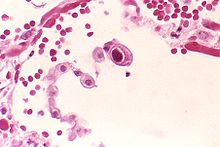
Cytomegalovirus infections

Cytomegalovirus (CMV) (from the Greek cyto-, 'cell,' and megalo-, 'large') is a genus of viruses in the order Herpesvirales, in the family Herpesviridae, in the subfamily Betaherpesvirinae. Humans and monkeys serve as natural hosts. There are currently eight species in this genus including the type species, Human betaherpesvirus 5 (HCMV, human cytomegalovirus, HHV-5), which is the species that infects humans. Diseases associated with HHV-5 include mononucleosis, and pneumonia. In the medical literature, most mentions of CMV without further specification refer implicitly to human CMV. Human CMV is the most studied of all cytomegaloviruses. Cytomegalovirus (CMV) (from the Greek cyto-, 'cell,' and megalo-, 'large') is a genus of viruses in the order Herpesvirales, in the family Herpesviridae, in the subfamily Betaherpesvirinae. Humans and monkeys serve as natural hosts. There are currently eight species in this genus including the type species, Human betaherpesvirus 5 (HCMV, human cytomegalovirus, HHV-5), which is the species that infects humans. Diseases associated with HHV-5 include mononucleosis, and pneumonia. In the medical literature, most mentions of CMV without further specification refer implicitly to human CMV. Human CMV is the most studied of all cytomegaloviruses. Within Herpesviridae, CMV belongs to the Betaherpesvirinae subfamily, which also includes the genera Muromegalovirus and Roseolovirus (HHV-6 and HHV-7). It is related to other herpesviruses within the subfamilies of Alphaherpesvirinae that includes herpes simplex viruses (HSV)-1 and -2 and varicella-zoster virus (VZV), and the Gammaherpesvirinae subfamily that includes Epstein–Barr virus. The genus of cytomegalovirus is in the group dsDNA, in the order Herpesvirales, in the family Herpesviridae, and the subfamily Betaherpesvirinae. Several species of Cytomegalovirus have been identified and classified for different mammals. The most studied is Human cytomegalovirus (HCMV), which is also known as Human herpesvirus 5 (HHV-5). Other primate CMV species include Chimpanzee cytomegalovirus (CCMV) that infects chimpanzees and orangutans, and Simian cytomegalovirus (SCCMV) and Rhesus cytomegalovirus (RhCMV) that infect macaques; CCMV is known as both Panine herpesvirus 2 (PaHV-2) and Pongine herpesvirus-4 (PoHV-4). SCCMV is called Cercopithecine herpesvirus-5 (CeHV-5) and RhCMV, Cercopithecine herpesvirus 8 (CeHV-8). A further two viruses found in the night monkey are tentatively placed in the genus Cytomegalovirus, and are called Herpesvirus aotus 1 and Herpesvirus aotus 3. Rodents also have viruses previously called cytomegaloviruses that are now reclassified under the genus Muromegalovirus; this genus contains Mouse cytomegalovirus (MCMV) is also known as Murid herpesvirus 1 (MuHV-1) and the closely related Murid herpesvirus 2 (MuHV-2) that is found in rats. Viruses in Cytomegalovirus are enveloped, with icosahedral, spherical to pleomorphic, and round geometries, and T=16 symmetry. The diameter is around 150–200 nm. Genomes are linear and non-segmented, around 200kb in length. Viral replication is nuclear, and is lysogenic. Entry into the host cell is achieved by attachment of the viral glycoproteins to host receptors, which mediates endocytosis. Replication follows the dsDNA bidirectional replication model. DNA templated transcription, with some alternative splicing mechanism is the method of transcription. Translation takes place by leaky scanning. The virus exits the host cell by nuclear egress, and budding.Human and monkeys serve as the natural host. Transmission routes are contact, urine, and saliva. All herpesviruses share a characteristic ability to remain latent within the body over long periods. Although they may be found throughout the body, CMV infections are frequently associated with the salivary glands in humans and other mammals. The CMV promoter is commonly included in vectors used in genetic engineering work conducted in mammalian cells, as it is a strong promoter and drives constitutive expression of genes under its control. Cytomegalovirus was first observed by German pathologist Hugo Ribbert in 1881 when he noticed enlarged cells with enlarged nuclei present in the cells of an infant. Years later, between 1956 and 1957 Thomas Huckle Weller together with Smith and Rowe independently isolated the virus, known thereafter as “cytomegalovirus” . In 1990, the first draft of human cytomegalovirus genome was published , the biggest contiguous genome sequenced at that time .
